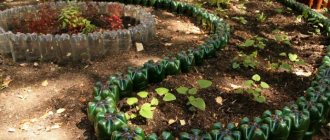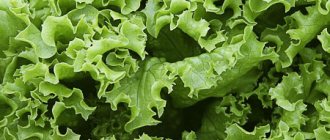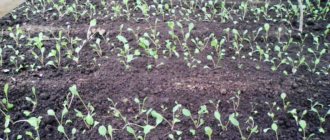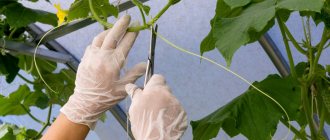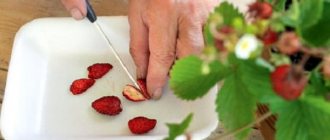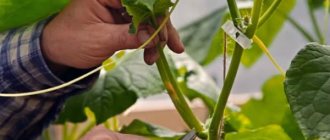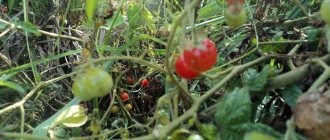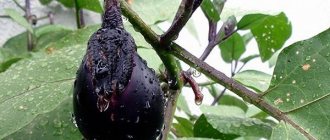Asparagus is widespread: in Europe, Asia, and Africa, this plant is actively grown in order to obtain juicy young shoots. Despite the fact that not everyone likes the characteristic taste of the vegetable, asparagus is constantly used in cooking as an irreplaceable source of many vitamins. Manganese, potassium, copper, vitamins B, K, A, E - all this is contained in shoots that you can grow in your own beds. Growing asparagus from seeds involves choosing the most fertile place on your site, since asparagus is demanding on the soil. You should also decide in advance whether you want to immediately immerse the seeds in open ground or first germinate them in a container and place the already strong seedlings in the garden. We'll talk about the intricacies of planting and caring for asparagus bushes below.
Growing asparagus from seeds
Why I decided to grow asparagus at my dacha
Asparagus (or asparagus) is a popular vegetable crop today. She is given such epithets as “miracle vegetable”, “royal plant”. It’s no surprise that I decided to give asparagus a place in my garden:
- This plant is a perennial. It can grow productively (forming up to 50 shoots) for 20 years on the same bed.
- Asparagus is not only incredibly tasty, but also a healthy vegetable, rich in elements necessary for the human body.
- The culture is cold-resistant and unpretentious: it feels great in both southern and Siberian weather. However, this characteristic depends on the variety: some asparagus cannot withstand spring frosts, while some survive frosts down to -30 C.
- Asparagus is one of the earliest crops. I collect the first shoots in April-May.
- There is a great variety of preparations for this vegetable - steaming, stewing, boiling, frying, grilling. Asparagus can be eaten raw, canned, or frozen.
I would like to add that this is an excellent crop for beginning gardeners. You can choose any of the methods of growing it, spend a minimum of time on care and enjoy a rich harvest.
Useful properties of asparagus
Asparagus is undoubtedly a delicacy and is not cheap. It is used in medicine and cooking. The fleshy stems contain oxalic, malic and citric acid, minerals, salts, pectin substances and vitamins, which are useful for the body. Young petioles are used to make jam, filling for pies, marmalade, serves as an additive to compotes and syrups, excellent jelly, and juice. This low-calorie product is widely used by nutritionists. It is recommended to be consumed by overweight people on a fasting day. The substances contained strengthen bone tissue and have a beneficial effect on the functioning of the kidneys, liver and heart. A large amount of folic acid is a must during pregnancy.
Recommended for people after a heart attack. Asparagine, which is part of the composition, dilates blood vessels, stimulates the work of the heart muscles and reduces blood pressure.
Coumarin cleanses the blood and prevents the formation of blood clots.
Removes waste and toxins from the body.
In cosmetology, the juice is used to cleanse and moisturize the skin, remove warts and calluses.
But there are also a number of contraindications. Excessive consumption of shoots accumulates salts from oxalic acid in the body, which causes urolithiasis.
True, there is another opinion that shoots are an excellent diuretic. If you have a tendency to allergies or personal intolerance to the product, start using small doses, or give it up altogether; in other cases, asparagus is undoubtedly recognized as a medicinal product.
The most delicious young, freshly picked shoots are eaten. The head is considered the most delicious.
Consumed frozen, boiled or canned.
The root part, up to 20 cm long, should not be rough or fibrous. After cleaning, immediately plunge the asparagus into cold water.
Cook for 20 minutes over low heat, lightly salting the water. The shoots are not placed, but placed in a saucepan, first tied into a bundle. Water is poured up to the middle of the shoots. Used as a separate dish or with sauces.
When to plant asparagus in the garden
There are no clear dates for planting asparagus in open ground. If you propagate it with seeds, then you need to soak them in April-May - by mid-June they will be ready to move to a permanent place. By this time, soil and air temperatures that are comfortable for asparagus will have been established in all Russian regions.
By region
If you are planning a spring transplant of cuttings, rhizomes, or asparagus seedlings, I recommend relying on these dates:
- The middle zone is the beginning of May.
- Siberia, Ural - mid-to-late May.
- Southern latitudes – mid to late April.
For autumn planting and replanting, I advise you to focus on the timing:
- The middle zone is mid-October.
- Siberia, Ural - early October.
- Southern latitudes – end of October.
I definitely study the long-term weather forecast - every season these dates shift slightly due to the presence or absence of the threat of frost.
According to the lunar calendar
Let me present favorable dates for planting asparagus:
- April: 1-4, 8-13, 15-19, 23-27, 29-30.
- May: 1-3, 7-11, 13-17, 21-25, 27-31.
- October: 1-4, 6-12, 16-20, 22-26, 30-31.
When growing asparagus from seeds, remember that the planting date is considered the beginning of development - placement in an aquatic environment (soaking).
Growing seeds using seedlings
The seedling method allows seedlings to grow stronger in gentle conditions so that by the time they are planted in open ground they will acquire a certain immunity. Before immersing the hatched seeds in containers, you should select the appropriate soil soil. The following ingredients are suitable for asparagus:
By using soil from the garden as soil for the container, you are acclimating the plant to its future permanent location in advance.
If you don’t want to prepare the soil mixture yourself, you can always purchase the finished product at a specialized store. There are both universal and crop-specific soil mixtures that already include a number of fertilizers.
The main disadvantage of such mixtures is that, while in them, the seedling does not get used to the garden soil and first encounters it only when planted in the ground, which provokes stress in the asparagus. If the plant gets to know the soil from your site in advance, its subsequent adaptation will be easier and faster.
Asparagus seedlings in plastic containers
Otherwise, caring for seeds in containers consists of steps that are familiar to any gardener who has dealt with seedlings at least once. Seeds immersed in separate pots are covered with a centimeter layer of soil. This layer is periodically sprayed. To create greenhouse conditions, the containers are closed with a transparent lid until the first shoots. A few days before planting in open ground, attention should be paid to fertilizing enriched with potassium.
By the way! Pots with a volume of 100-150 milliliters or plastic cassettes are well suited for asparagus.
Asparagus varieties for growing in the country
Cultivated asparagus has more than 300 plant varieties. I’ll omit the decorative and medicinal ones and introduce you to the most famous varieties of vegetable asparagus.
In the open ground
Although asparagus is an unpretentious, frost-resistant plant, I recommend choosing early, mid-season varieties for open beds:
- Snowy head. A mid-early variety with small shoots with a pointed, loose greenish-cream head. It is distinguished by very delicate pulp, the taste of which can be compared to green peas.
- Arzhentelskaya. The plant produces large, snow-white, low-fiber shoots. They can be eaten fresh or canned.
- Early yellow, Harvest-6, Danish white. Varieties specially bred for growth in open beds.
I don’t stop at one variety – I’m constantly looking for and trying new ones.
In the greenhouse
For growing in open ground, pay attention to ultra-early, late-ripening varieties:
- Glory to Brunswick. One of the popular varieties that produces juicy and tender snow-white shoots. They are suitable for both fresh consumption and canning. The variety is distinguished by its excellent taste and good yield.
- Сonnovers Colossal. An early-ripening variety that thrives in greenhouses.
- Franklin. High-yielding hybrid for closed ground.
- Sieve. A hybrid variety bred by French breeders.
- Mary Washington. A high-yielding variety obtained by American scientists.
Varieties for greenhouses are also quite suitable for home growing in pots.
What does Argentelian asparagus look like?
Asparagus is a perennial herbaceous plant; with proper care, its productive life span is 17–20 years. It is a “bush” of thin shoots that begin to branch intensively approximately 20–25 cm from the base. The leaves are more like soft needles. Many Russians are more familiar with asparagus not as a product, but as a decoration for bouquets. Until now, it is often planted not for consumption, but as an element of landscape design. The crop looks decorative both during summer and autumn, when bright greenery effectively sets off the coral-red berries.
Asparagus is often grown by gardeners just to decorate their own garden.
Plants are divided into “male” and “female”. The latter are not held in high esteem by gardeners due to their relatively low yields. The former surpass them in this indicator by about 25%. But the shoots on “male” plants are noticeably thinner.
During the first two years after planting, asparagus is a low branch. The growth is almost unnoticeable. This is explained by the fact that at this time it forms the root system at an intensive pace. The rhizome of the plant is very powerful, fleshy, due to this, asparagus tolerates adverse weather conditions well and stably forms growth buds, regardless of cold, drought, and so on.
Many people recognize asparagus, but it is not the edible shoots, but the fluffy “panicles” that used to decorate any bouquets
Then the “twig” gradually begins to branch. The first harvest (2–3 shoots) is cut only in the third year. From an adult plant you can get 40–50 shoots about 20 cm long. Their length increases almost before your eyes - up to 3 cm per day. The yield of asparagus is low - 2.1 kg/m², in especially successful years 3.5–4 kg/m².
You will have to wait three years for the first fruiting of Argentelskaya asparagus, then the yield will gradually increase as the bush grows
This is one of the first crops to bear fruit in the next season. Asparagus shoots are cut as early as May. Only wild garlic or greens planted before winter - onions, lettuce - can compete with it in this regard. The fruiting period of young specimens lasts 12–15 days.
In spring, asparagus shoots appear almost from under the snow.
Arzhentelskaya is one of the most common varieties of asparagus in Russia. This is the development of foreign breeders, slightly “corrected and supplemented” by Soviet specialists. It appeared in the public domain in the early 50s of the last century. At the same time, the variety was included in the State Register. There are no restrictions regarding the growing region.
Arzhentelskaya is one of the few asparagus varieties successfully cultivated in Russia
The height of the plant reaches 1.5–1.7 m. The shoots used for food are quite thin - no more than 1 cm in diameter. In general, they are snow-white with a barely noticeable pinkish tint, but in the open air they quickly change shade to light green with an inky purple tint. The flesh is creamy or has the shade of butter. At the end of summer, round “fruits”-boxes ripen. Each contains one seed.
Asparagus fruits are inedible; they are only suitable for collecting seeds yourself.
The Argentelskaya asparagus variety has many undeniable advantages. First of all, we can note its cold resistance (down to -30°C), early ripening, relative undemanding care, excellent taste and high content of health-promoting microelements and vitamins. Its disadvantages are the same as those inherent to the crop as a whole - low yield and short shelf life. There is no time to delay harvesting. Overripe shoots quickly lose moisture and become coarser.
Fresh Argentelian asparagus tastes like young green peas. The stems are soft and juicy, practically without fiber. When heat treated, they retain their shade and shape. Its shoots are valued for their high content of asparagine (an amino acid that the body cannot produce on its own) and coumarin. It contains slightly less saponin, a substance essential for the synthesis of many hormones, especially serotonin, norepinephrine, and dopamine. The first is considered the “hormone of happiness,” that is, asparagus helps get rid of depression, causeless anxiety, and get rid of sleep problems.
With its regular consumption, blood pressure normalizes and the condition of the cardiovascular system as a whole improves. Nutritionists also note the positive effect of asparagus on the liver and kidneys. It has a pronounced diuretic effect, removing excess fluid, toxins and salts from the body.
It is recommended to include it in the diet for diabetes of any type, joint diseases and increased bone fragility. But you need to eat your own asparagus within 4-5 days after cutting. Most of the nutrients are then lost. The same thing happens when canning and freezing.
Asparagus is rich in vitamins A, C, E, K, PP, group B, organic acids, fatty oils, and alkaloids. It also has a high fiber content. Microelements include copper, iron, sodium, phosphorus, selenium, magnesium, potassium, manganese, and zinc. Folic acid makes it an indispensable product for pregnant women. It prevents the development of fetal pathologies and reduces the risk of miscarriage. And all this with an extremely low calorie content - 21-30 kcal per 100 g.
The product is also in demand in cosmetology. Argentelian asparagus juice can be used to cleanse, nourish and soften the skin. In folk medicine, it is used to combat old rough calluses and small warts, heal wounds, ulcers and burns.
Information about the health risks of asparagus is contradictory. It is believed that with its prolonged and excessive use, oxalic acid accumulates in the body, which can provoke the development of cholelithiasis and urolithiasis if there is a genetic predisposition to this, irritate the mucous membranes of the digestive system, and cause salt deposition in the joints. Another not very pleasant consequence is a change in the smell of sweat due to the release of sulfur compounds by the glands.
Asparagus is not recommended for children under two years of age. Heavy fiber is poorly digested by a weak stomach. It is also rare, but possible, to develop allergies.
You can prepare many delicious and healthy dishes from asparagus. It is an integral component of English, Italian, and German cuisine. In addition to eating fresh, asparagus can be grilled, steamed, or boiled. It is included in recipes for stews, soups, salads, and is used as a filling for pies.
Asparagus salad is a storehouse of vitamins and microelements, and it’s also very tasty.
Video: health benefits of asparagus
Choosing a place and soil for planting asparagus
Asparagus does not “present” any special requirements for the place of growth. Prefers well-lit, weed-free places, fertile and light substrates. According to my observations, it feels best on sandy loam soil. When choosing a place for asparagus, keep in mind that this crop is perennial. I usually plant it along the walls of outbuildings or near the fence.
Soil preparation varies slightly depending on when you choose to plant it. In the spring, I try to plant the rhizomes of the plant before the buds begin to develop:
- I fertilize the asparagus plot with humus - 10 kg of fertilizer per 1 m2.
- I dig up the earth onto the bayonet of a shovel.
- The row spacing is at least 60 cm. Between plants in the same line is at least 30 cm. I try not to plant more than 3-4 rhizomes per “square”.
- I dig trenches 30 cm deep for the seed. I cover the rhizomes with substrate so that they remain in the recess.
- Finally, I water the plantings thoroughly.
Another way to plant asparagus is before winter. Here you need to thoroughly fertilize the soil:
- For 1 m2 of ridge I add 20 g of ammonium sulfate, 60 g of superphosphate, 30 g of potassium sulfate.
- I'm digging up the area.
- I plant rhizomes according to the same 60x30 cm pattern.
- I do not bury the seed material into the substrate, but, on the contrary, I make an earthen mound above it, which will protect the rhizomes from winter frosts.
Asparagus goes well with many vegetable crops - radishes, beans, lettuce. Therefore, in the first summers, when asparagus does not grow much, I plant these plants between the rows.
Sowing asparagus seedlings
Many gardeners and gardeners do not like to grow asparagus with seeds, as they blame this method for poor germination. But I have verified in my own experience that it works very well if you do the right preparation. Depending on the region, asparagus can be grown using this method either through seedlings or by direct sowing in an open bed.
I start planting seedlings around the beginning of April:
- I’m preparing a soil mixture: last year’s manure + peat + sand + garden soil (1:1:1:2). I treat it with a solution of potassium permanganate.
- I dilute a little growth stimulant in warm water. I soak the seeds in liquid for 2-4 days.
- I wrap the seed in a damp cloth and wait until seedlings 1-3 mm long appear.
- I prepare seedling cassettes or individual cups and pots.
- I plant the seeds in the prepared soil mixture, deepening them to 1 cm.
- I take it to a warm place (25-27 C).
Let me warn you that asparagus seeds take a very long time to germinate - I waited 1.5 months. Then green “feathers” appear above the ground - asparagus seedlings.
Seedling care
Until the seeds have sprouted, they also need care - spraying the soil with a spray bottle as it dries. There is an easier way: before germination, cover the bowl with the seedlings with glass. But do not forget to periodically ventilate and wipe the glass from condensation.
After the first shoots appear, care does not change. Continue to irrigate the soil mixture with water from a spray bottle. Do not forget to remove the glass when the first shoots appear - otherwise they will suffocate.
Picking
Asparagus seedlings are ready for planting in a permanent place by mid-June. You can replant the rhizomes in the fall or next spring. Before moving, plants are recommended to be trimmed - shortening the roots by 3-4 cm. I use a technical knife for this, not forgetting to treat it after each plant in a disinfectant solution.
Transplanting
I carry out all the necessary preparations and planting according to simple instructions:
- In the fall, I clear the selected area of weeds and plant waste.
- I add 10-15 kg of last year's manure or compost per 1 m2. I dig the ground deep.
- In the spring I carefully loosen the area.
- I make rows at a distance of about 70 cm.
- The depth of each hole for asparagus is 30 cm, the distance between seedlings in one line is at least 40 cm.
- I pour humus into the bottom of the depression in a mound - such a height that the top is at ground level. If the soil on the site is fertile, humus can be replaced with ordinary garden soil.
- I carefully straighten the roots of the seedling with my hands in the formed mound. I sprinkle the plant with 5-7 cm of soil and compact it with my palms.
- I water the plantings - as soon as the moisture is absorbed, I mulch the bed. To do this, you can use the same garden soil, as well as straw, compost, sawdust, pine needles and other light organic compounds.
Now all that remains is to wait until the plant takes root and provide it with simple care.
Harvest and storage
The harvest is harvested in the 3-4th year of asparagus growth. Young cuttings are cut using a sharp knife using the following technology:
- The base of the bush is cleared of mulch.
- Young shoots that barely lift the soil crust are cut out.
- Cover the hole with soil to allow new shoots to appear.
Those plants that are on the soil surface lose their taste and become tougher and more fibrous.
The most valuable and nutritious are the young shoots that have barely hatched. Asparagus keeps well fresh on the bottom shelf of the refrigerator. To preserve its taste, it is recommended to spray it with water once every 10 days. The period of such storage reaches 2-3 months.
For longer storage, use the freezer. The cuttings are washed well under running water, dried, placed in a plastic bag and frozen.
Asparagus can be used for pasteurization in marinade. There are a lot of recipes that allow you to preserve its taste under the lid of a jar.
Sowing asparagus seeds in open ground
Let me immediately explain that in open ground I do not immediately plant asparagus in a permanent place - the first “habitat” is the seedling beds. I begin work in the spring, as soon as the threat of frost has passed and the soil has warmed up to at least 15 C. I will explain the entire technology in order:
- Since it will take a very long time to wait for dry seeds to sprout, the first thing I do is soak them in warm water (about 30-35). I move the bowl to a warm place - to the same heating battery.
- It is enough to soak asparagus seeds for 5-6 days. I don’t forget to change the fluid to fresh one every day.
- I wrap the seed material in damp cloth for 3-7 days until germination. To prevent the fabric from drying out, I place it in a plastic bag, which I tie tightly.
- While the seeds are hatching, I prepare a seedling bed for them. I add 10 kg of rotted compost or manure per 1 m2. Organics can be replaced with a complex mineral complex - 100 g of composition per 1 m2.
- I leave row spacing up to 25-40 cm, I sow the seeds themselves, maintaining gaps in the line of 5-7 cm. Planting depth is approximately 2 cm.
- After 3-4 weeks, I thin out the seedlings - leaving only strong shoots. The distance between them is at least 10-15 cm.
From my own experience, I judge that asparagus seedlings in open ground develop very slowly - over the summer they will grow by 10-15 cm. Therefore, they will be ready for transplanting to a permanent place only in the spring-autumn of the next season. All this time she needs to be provided with the same care as adult plantings:
- Regular watering, loosening, weeding.
- Fertilizers. In June - 1-2 fertilizing with nitrogen composition. For 1 m2 – 10 g of urea or ammonium nitrate. Can be replaced with organic matter - a solution of manure (1:6). At the end of August - fertilizing with mineral fertilizers (phosphate and potassium) strictly according to the instructions.
By October, I cover the asparagus seedlings with a layer (3-5 cm) of peat or humus. I additionally protect the top with decayed leaves or spruce branches.
How to choose the right active seeds?
You can check the activity or germination of asparagus seeds by soaking them in special solutions:
- Salty water. Dissolve 1 tsp in 200 ml of warm liquid. salt and stir until completely dissolved. Cool the resulting mixture to room temperature, and then pour 10-20 seeds into it. Mix the mixture and leave the seed in the water for 7-10 minutes, after this time evaluate the result. Dry seeds remain on the surface and are thrown away. Viable kernels remain at the bottom of the glass, they are dried and stored until sowing.
- Manganese solution. The method has no fundamental differences from the previous one. To check the activity of the seed, you will need a slightly pink solution of manganese. The advantage of this product is that the active component also provides additional disinfection of the kernels and improves their shelf life.
The collected asparagus seeds are carefully examined. They should be dark in color, dense and intact. Damaged elements are immediately rejected and thrown away; they are not used for sowing due to insufficient germination.
Unclaimed seeds can be dried, placed in a cloth bag and stored in a dry, dark place until the next season. The shelf life of freshly harvested asparagus seeds is 4-6 years.
Methods for propagating asparagus
Sowing by seeds is far from the only method of propagating asparagus. Let me introduce you to other popular methods:
- Dividing bushes. This is the easiest plant to propagate and is available in spring, summer and fall. If your neighbors grow asparagus, contact them during replanting (young asparagus is replanted annually, and adult asparagus every 10 years). Choose shoots for planting that have at least 1 shoot.
- Propagation by petioles. From March to June, asparagus can be propagated through last year's shoots. They are cut into cuttings, which are then rooted in moist sandy soil. For better development, the cuttings are covered with a cap from the same plastic bottle. Caring for such seedlings is not difficult - you need to periodically remove the caps for ventilation and moisten the plants by spraying. After 1-1.5 months they are already producing roots - the asparagus is picked and transplanted to a permanent bed.
I recommend starting to grow asparagus with easy methods (cuttings, rhizomes, divisions), and only then try new varieties by buying seeds.
growing asparagus
Preparing the bed
The place for planting asparagus in the garden plot is chosen very carefully. This perennial plant develops an extremely powerful root system over time. It will not be possible to uproot it manually later, even if you want to.
This plant loves sunlight and warmth, so the area should be open. But at the same time, protection from gusts of cold wind is required. It is advisable that within a meter or one and a half from the asparagus planting there is a wall, a fence, a “curtain” of tall plants, a hedge, and so on. It will not shade the garden bed, but will cover it from sharp drafts.
Asparagus loves warmth and sunlight, this must be taken into account when choosing a place for it
A fertile but heavy substrate is not the best option for Arzhentelskaya. Asparagus loves soil that is nutritious, but also has good aeration and allows water to pass through. In clayey, silty, peaty soil, or chernozem, it will not produce good harvests.
To plant crops in the fall, dig a trench approximately the depth of a spade. It is half filled with humus or rotted compost mixed with approximately an equal volume of peat chips and half as much coarse sand. At the bottom, a layer of drainage at least 3–5 cm thick is required. Crushed stone of fine fractions, pebbles, clay shards, and expanded clay are suitable for this.
The bed for asparagus must be prepared in advance
As for acidity, the substrate should be neutral or slightly alkaline (pH 6.5–7.5). Dolomite flour, slaked lime, and raw egg shells crushed to a powder are added to acidic soil; fresh sawdust from coniferous trees or peat is added to alkaline soil.
Dolomite flour is a natural soil deoxidizer; if you follow the dosage recommended by the manufacturer, it has no side effects
Next spring, the nutrient mixture at the bottom of the trench is well loosened and mineral fertilizers are added in the process, embedding them into the soil. There should be at least a month left before seedlings are planted. You can use complex preparations containing nitrogen, potassium and phosphorus (Diammofoska, Azofoska) or add these macroelements separately. In the first case, you will need about 100 g/m², in the second - 50 g of simple superphosphate, 40 g of potassium nitrate and 20 g of urea. Natural fertilizers can use wood ash (0.5 l/m²). Fertile soil mixed with humus is poured on top, forming a ridge 7–10 cm high.
Humus is an effective means of improving soil fertility.
Drainage and a raised bed will help prevent water from stagnating at the roots. Asparagus Argentels, like its other “relatives,” categorically does not tolerate waterlogged substrate. In this case, the roots quickly rot and the plant dies. The same thing happens if groundwater comes closer to the surface than a meter.
When planting several Argentelskaya asparagus bushes at once, you need to take into account that each of them requires about 0.25 m² of area for nutrition. The interval between them is at least 60 cm, the distance between the rows is 120–150 cm. Thus, no more than 3–4 plants can be placed per 1 m².
When planting asparagus in the garden, be sure to observe the interval between plants.
The holes for them are made quite large, 30–35 cm deep and approximately the same diameter. Plantings are quite sparse, asparagus takes up a large area, and the yield leaves much to be desired. To save space in your garden plot, you can plant greens, onions, garlic, radishes, cherry tomatoes, and vegetable beans in the rows and between plants.
Many gardeners refuse to plant asparagus also because they do not have enough space on the plot - the crop occupies a large area, but does not differ in yield
Caring for asparagus in open ground
One of the obvious advantages of this vegetable is its easy care. It comes down mainly to watering, loosening and fertilizing.
Watering
Asparagus is not a moisture-loving plant. It requires systematic watering, but in small portions. Both waterlogging, stagnation of moisture, and excessive drying out of the soil are detrimental to the crop.
watering asparagus in the garden
Feeding
Asparagus is one of the plants susceptible to fertilizer. I checked it from my own experience - the yield of asparagus directly depends on the timeliness of fertilizing. As you remember, both in spring and autumn we plant the plant in already fertilized soil. After that I follow a simple schedule:
- About a month after sowing, I fertilize the planting with a solution of mullein (1 part dry mass to 5 parts water).
- Every year after harvesting (approximately by the end of June) I add mineral nutrition: per 1 m2 - 30 g of urea, 30 g of potassium salt, 30 g of superphosphate.
- By July (then the asparagus “starts to grow” again after cutting the crop), organic fertilizer is needed - for example, an aqueous solution of chicken manure (1:10).
- The last feeding of asparagus should be done before the first frost - in the last weeks of October. Most often I use a complex organic composition or add potassium salt and superphosphate (30 g of each preparation per 1 m2).
When flowering, asparagus does not need fertilizers - I successfully replace them with mandatory treatment with insecticides. This simple prevention allows you to forget about pests.
fertilizers for feeding the garden
Weeding and loosening
I have already written that asparagus does not do well when surrounded by weeds. Therefore, I periodically manually weed the bed once every 1-2 weeks.
I don’t forget to carefully loosen the plants after each watering or heavy rain, breaking up the dense earthen crust. Over the summer, the plant needs at least 7-8 such procedures.
Hilling
Asparagus grows on ridges - I pre-shape them when sowing or replanting the crop. As the plant grows, I maintain the height of the mounds, which are eroded by watering and rain. But only until the harvest - by April I carry out “unplanting”.
On a flat surface it is easier to notice the appearance of edible asparagus sprouts. This comparison of ridges gives the plant the opportunity to develop stems and accumulate more nutrients. After harvesting, I carry out hilling again.
In the fall, I cut off all ground shoots on both mature and young plantings. I hill up the plants again and additionally insulate them with a layer (about 5 cm) of compost or peat - you will need at least 1.5 buckets per 1 m2.
General information about the plant
Asparagus (asparagus) is a medium-sized plant that produces edible shoots. The vegetable crop fell in love back in the Middle Ages, and only nobles were allowed to grow it. Asparagus received such superiority not only for its unique taste, but also for its biological value:
- Magnesium and potassium, which take an active part in the metabolic processes of the peripheral nervous system.
- Calcium, necessary for the full development of bone tissue, teeth and hair.
- Folic and ascorbic acids - normalize metabolic processes in the body, remove waste and toxins, and help preserve youth.
- Beta-carotene and choline support vision.
How asparagus grows
The rich composition of asparagus returned the plant to the diet, giving it a worthy place between tomatoes, cucumbers and cabbage. Planting and growing asparagus in the garden has become popular due to the rich vitamin and mineral composition of the plant.
What difficulties arise when growing asparagus?
Although asparagus is an unpretentious crop, when growing it we may encounter problems - infections and pests.
Disease Prevention
I note that asparagus is a very disease-resistant plant. However, the causative fungus Helicobasidium purpureum poses a great danger to it. When damaged, asparagus withers within a few days. The disease can be easily identified by the shedding of “openwork” from the branches. But this is only a visible manifestation: the above-ground part begins to die off after severe damage to the root collar and root system.
Prevention of such an infection is treatment with Fundazol. Already infected plants cannot be saved - they need to be dug up and destroyed. Healthy neighbors are also treated with Fundazol and additionally isolated with cling film.
The plant may suffer from fusarium - root rot. The branches also begin to crumble and the asparagus dies. At the initial symptoms, fusarium is eliminated with the same “Fundazol”. If the disease is advanced, the only thing left to do is destroy the plant.
Another common disease of asparagus is rust. The shoots become covered with dark spots, which increase in size - pathogenic spores ripen in them. The infection can be controlled with systemic fungicides. Prevention consists of disinfecting the soil and the seeds themselves before planting. The easiest way to do this is to use a strong (raspberry) manganese solution.
Pest Control
I'll tell you about uninvited guests that can harm vegetable asparagus:
- Asparagus leaf beetle. The larvae of this pest gnaw the green part of the bushes - the plants quickly die from such damage. You can resist the leaf beetle by using insecticides - “Fufanon”, “Fitoverma”, “Aktellika”, etc.
- Asparagus fly. The pest feasts on young spring shoots and gnaws tunnels in them, making them inedible. You can save plants from flies by treating them with chlorophos.
asparagus leaf beetle
In order not to resort to chemicals, I do not forget about preventive measures:
- I plant lavender, calendula, marigolds, basil, and tomatoes nearby. These plants can repel pests.
- I do not plant asparagus on acidified and heavy soils. The normal value for a plant is pH 6-7.
- I promptly remove weeds and plant debris from the beds.
- I do not allow the substrate to become waterlogged.
- In the fall, I trim and burn all asparagus shoots.
- Before planting or replanting asparagus, I disinfect the area with Bordeaux mixture, Fitosporin or Topaz.
Asparagus is easy to grow, tasty and healthy. Does not require specific care, is resistant to unfavorable climates, pests and infections. Since there are many ways to grow asparagus, even a beginner can grow it.
Diseases and pests
Since asparagus grows in open ground, the bush is often affected by pests and diseases, including:
- Red root rot is a fungal disease caused by Helicobasidium purpureum. The fungus attacks the roots and root collar, and subsequently the entire plant dies. A bald spot appears on the area. To destroy, diseased bushes are treated with a solution of foundationazole and wrapped in film. If the infection is severe, the fungus cannot be removed, so the entire plantation is destroyed and a new one is planted.
- Asparagus leaf beetle - small black or yellow insects destroy leaves. Actellic and similar drugs are used to combat this. Asparagus is susceptible to pests such as mole crickets, cockchafers, slugs, and wireworms.
- Rust is another fungal disease. The surface is covered with a rusty coating in the form of spots. The defeat occurs from mid-summer. The shoots stop developing, the growing season stops, the leaves turn yellow, and the yield decreases. Appears on plants with wet, heavy and poorly permeable soils, where there are frequent cases of water stagnation.
- The asparagus fly is a small, gray insect with yellow legs. They feed on sap from the leaves and make tunnels in the shoots. After some time, the shoots wither and dry out.
- Rhizoctonia is a disease of root crops. Bushes are sometimes affected by this disease. As a preventive measure, plants are seasonally treated with fungicides (Topaz, Topsin M, Fitosporin), karbofos. Karbofos is a non-toxic and odorless substance and is used at the first detection of pests. Regularly inspect the soil for the presence of larvae, remove weeds, dead parts of roots and ground branches in a timely manner.
Harmful insects and diseases
Asparagus is highly disease resistant, but the fungus Helicobasidium purpureum can destroy the plant in just 2 days. Falling branches is the first sign that the bush should be treated with Fundazol.
Leaf beetle larvae eat asparagus foliage, causing the death of the plant. Insecticides “Fufanol”, “Fitoverm” and the like help in the fight against this pest.
Asparagus flies are another problem that threatens the health of the plant. The pest larvae damage the shoots, their growth stops, and the consumer qualities of the vegetable are lost. Fight the fly with chlorophos.
Forcing shoots in winter and spring
To obtain edible asparagus shoots in winter greenhouses and greenhouses in the spring, rhizomes of plants aged 5–6 years are used. To do this, they are dug up in the fall and stored in the basement at an air temperature of 0 - +2 degrees C. At the beginning of winter, they are placed in small containers. Planting density per 1 sq. m is 18 - 20 plants. A layer of humus 20 cm high is poured on top and covered with an additional opaque film. The containers are placed in a greenhouse.
Before the roots begin to grow, the greenhouse is maintained at +10 degrees C; with the start of bud growth, the temperature is brought to +18 and maintained throughout the entire harvest period (2 months).
Variety or hybrid?
When growing a varietal crop, you will get female, male and hermaphrodite plants in different proportions. When growing a hybrid, it is predominantly male plants.
For a better harvest, it is better to grow asparagus in a school and select male plants (with small yellow flowers) in the 2nd year.
Inedible red berries are formed on the female ones.
Male plants are more developed and have more stems than female or hermaphrodite plants. The yield from male plants alone is 25-50% higher than from mixed plantings.
What does asparagus like?
The methods for growing asparagus for bouquets and for food are somewhat different. Everything is simple with bouquets. They planted it where it will look beautiful, and it grows. And in order to be able to enjoy the tender shoots, and for there to be a lot of them, you need to create conditions for the plants. And these conditions are:
1. Loose, nutritious, preferably sandy, soil. On low-nutrient soil, the shoots will turn out rough and skinny. 2. Acidic soil is unacceptable; asparagus does not like even slight acidity. 3. Good soil moisture, otherwise the shoots will be bitter and hard.
For planting, you need to choose a sunny place, but a little shade is acceptable. Close groundwater is excluded. When planting, you need to take into account that the root system of asparagus is very well developed and mostly lies in the soil close to the surface, but individual roots can go very deep. The rhizome grows annually from above and dies from below, as a result of which over time the bush and root system rise upward to the soil surface. That is why asparagus bushes must be mulched every year.

